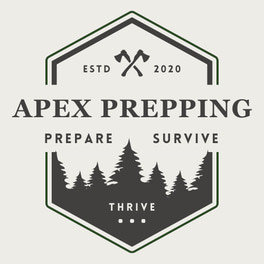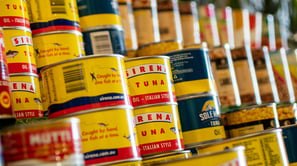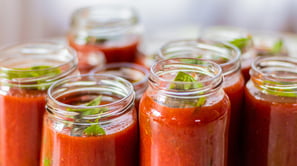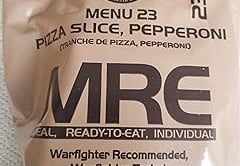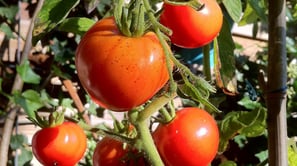Food Security
As preppers, we understand the significance of food security in times of uncertainty. In this community, we prioritize being prepared for any situation, including ensuring a stable food supply.
Emergency Cooking Methods:
Campfire cooking, rocket stoves, and solar ovens.
Edible Insects and Protein Sources:
Exploring alternative protein options.
Food Security in Urban Environments:
Strategies for city-based preppers.
Emergency Food Storage Strategies: Stockpiling and Rotating Food Supplies
In a world filled with uncertainties, having a well-thought-out emergency food storage plan is not just a precaution; it's a necessity. Natural disasters, economic crises, and unforeseen emergencies can disrupt the regular food supply chain, making it crucial to be prepared. To effectively manage your emergency food storage, it's essential to understand the principles of stockpiling and rotating your food supplies.
1. Assess Your Needs: Before you start stockpiling food, evaluate your specific needs. Consider factors such as the size of your family, dietary restrictions, and any special requirements (like baby food or pet supplies). This assessment will help you determine how much food you need to store.
2. Choose the Right Foods: When selecting foods for your emergency storage, opt for items with a long shelf life. Canned goods, freeze-dried meals, rice, pasta, dried beans, and sealed grains are excellent choices. Make sure to include a variety of foods to ensure a balanced diet.
3. Calculate Storage Space: Find an appropriate space in your home for food storage. Basements, pantries, and closets work well, but ensure the area is cool, dry, and away from direct sunlight. Invest in airtight containers and shelving to maximize space and maintain food quality.
4. Rotation System: Food rotation is essential to prevent items from expiring before you can use them. Employ the "first in, first out" (FIFO) method, which means using the oldest items in your stockpile first. Label your items with purchase or expiration dates to make this process easier.
5. Maintain an Inventory: Create an inventory list of all items in your emergency food storage. This list should include the quantity, expiration date, and location of each item. Regularly update the list as you add or use items to ensure you always know what you have on hand.
6. Monitor and Replenish: Keep an eye on the expiration dates of your stored food. As items approach their expiration dates, plan to use them in your regular meals and replace them in your storage with fresh items. This proactive approach ensures you don't waste food and maintains the quality of your emergency supplies.
7. Rotate Non-Perishable Items: Not all emergency supplies need to be food. Include essential non-perishable items like first-aid supplies, toiletries, batteries, and flashlights in your storage. Rotate these items periodically to ensure they remain functional.
8. Plan Your Menu: It's a good idea to plan meals around the items in your emergency storage. Familiarize yourself with recipes that use your stored foods, so you can cook balanced meals even during challenging times.
9. Consider Dietary Needs: If you or your family members have specific dietary restrictions or allergies, ensure your emergency food storage accommodates these needs. Stockpile suitable alternatives to meet dietary requirements.
10. Stay Informed: Stay updated on local emergency alerts and prepare for disasters or crises that are more likely to occur in your region. Adjust your food storage accordingly based on the potential duration of the emergency.
Remember, emergency food storage isn't just about hoarding food; it's about having a plan to sustain your family during difficult times. Regularly review and update your stockpile to ensure it remains effective and reliable. By following these strategies and being proactive in managing your supplies, you can provide a sense of security and peace of mind for you and your loved ones in times of need.
Long-Term Food Preservation Techniques: Canning, Dehydrating, and Vacuum Sealing
Introduction:
In today's fast-paced world, ensuring the availability of fresh and nutritious food year-round is essential. Long-term food preservation techniques play a crucial role in extending the shelf life of various food items, allowing us to enjoy them even when they are out of season. Among the most popular methods are canning, dehydrating, and vacuum sealing. In this post, we will explore these techniques in detail, highlighting their processes, benefits, and best practices.
1. Canning:
Canning is a time-tested method of preserving food that involves sealing food in airtight containers and heating them to destroy any microorganisms that can cause spoilage. The process typically includes the following steps:
Preparation: Clean and chop the food items to be preserved.
Sterilization: Sterilize jars, lids, and other canning equipment to prevent contamination.
Filling the Jars: Pack the prepared food into sterilized jars, leaving appropriate headspace.
Sealing: Apply lids and screw on bands, ensuring they are properly tightened.
Processing: Process the jars in a boiling water bath or pressure canner to kill bacteria, yeasts, and molds.
Cooling and Storage: Allow the jars to cool and check for proper seals before storing them in a cool, dark place.
Canning Benefits:
Preserves flavors and nutrients.
Extends shelf life for up to several years.
Requires minimal storage space when compared to fresh produce.
2. Dehydrating:
Dehydrating, or drying, removes moisture from food, preventing the growth of bacteria, yeasts, and molds. This technique involves air-drying or using specialized dehydrators to remove moisture content from various foods:
Preparation: Clean and slice the food items uniformly for even drying.
Drying Process: Arrange the prepared food on dehydrator trays or use natural methods like sun drying.
Monitoring: Regularly check the food for dryness to prevent over-drying.
Storage: Store the dehydrated items in airtight containers in a cool, dark place to maintain quality.
Dehydrating Benefits:
Preserves natural flavors and nutritional content.
Lightweight and space-saving.
Ideal for creating snacks, camping meals, and emergency food supplies.
3. Vacuum Sealing:
Vacuum sealing involves removing air from specially designed bags or containers and sealing them to prevent the growth of spoilage-causing microorganisms. The process typically includes these steps:
Preparation: Clean and portion the food items.
Vacuum Sealing: Place the items in vacuum-seal bags or containers and use a vacuum sealer to remove air and create a tight seal.
Storage: Store the vacuum-sealed packages in a cool, dry place, away from direct sunlight.
Vacuum Sealing Benefits:
Extends the shelf life of food by inhibiting the growth of bacteria.
Preserves flavors and nutrients.
Prevents freezer burn in frozen items.
Incorporating canning, dehydrating, and vacuum sealing into your food preservation repertoire provides you with a diverse array of options for storing and enjoying your favorite foods year-round. By understanding the techniques and following best practices, you can create a well-stocked pantry, ensuring that you and your family have access to nutritious and delicious meals regardless of the season. Whether you're an avid homesteader, a camping enthusiast, or simply someone looking to minimize food waste, these long-term preservation methods offer practical solutions for preserving the harvest and preparing for the future.
MREs (Meals Ready to Eat): A Comprehensive Guide to Pros, Cons, and Proper Use in Survival Situations
In the realm of emergency preparedness and survival situations, having access to reliable and nutritious food is paramount. Meals Ready to Eat (MREs) have become a popular choice for individuals, military personnel, and emergency responders due to their convenience and long shelf life. In this post, we will delve into the pros and cons of MREs, as well as their proper use in survival situations.
Pros of MREs:
Long Shelf Life: One of the primary advantages of MREs is their extended shelf life. MREs are designed to last for several years, ensuring that they remain edible and safe to consume even in the harshest conditions.
Convenience: MREs are pre-packaged, portable meals that require no cooking or additional preparation. Each MRE contains everything needed for a complete meal, including the main dish, side items, desserts, snacks, beverages, and utensils. This convenience is invaluable, especially in emergency situations where resources and time may be limited.
Nutritional Value: MREs are carefully formulated to provide a balanced and nutritious meal. They typically contain a mix of proteins, carbohydrates, fats, vitamins, and minerals, ensuring that individuals receive essential nutrients to sustain their energy levels and overall health.
Variety: MREs come in a wide range of menu options, catering to different tastes and dietary preferences. This variety prevents meal fatigue, ensuring that individuals have diverse food choices during extended periods of emergency situations.
Durability: MREs are designed to withstand rough handling and adverse environmental conditions. Their sturdy packaging protects the contents from moisture, light, and physical damage, making them suitable for various survival scenarios.
Cons of MREs:
Cost: MREs can be relatively expensive compared to other emergency food options. However, the cost is often justified by the convenience, nutritional value, and long shelf life they offer.
Weight: MREs are dense and can be heavy, especially when carrying multiple meals for an extended period. This weight can be a concern for individuals who need to travel light or cover long distances on foot.
Taste: While MREs have improved significantly in taste over the years, some individuals may find the flavor and texture of certain items less appealing than freshly prepared meals. However, the variety of menu options helps mitigate this issue to some extent.
Waste: MRE packaging generates waste, which may be a concern in situations where proper disposal is challenging. However, efforts are being made to design eco-friendly packaging for MREs to address this issue.
Proper Use in Survival Situations:
Rotate Stock: If you plan to use MREs for emergency preparedness, it's essential to regularly check the expiration dates and rotate your stock. Consuming fresh MREs ensures maximum nutritional value and taste.
Supplement with Other Foods: While MREs provide a convenient source of nutrition, it's advisable to supplement your diet with fresh fruits, vegetables, and clean water whenever possible. This balance ensures a well-rounded and varied nutrient intake.
Training and Familiarity: Familiarize yourself and others with the contents and proper use of MREs before an emergency situation arises. Knowing how to efficiently open, heat (if required), and consume an MRE can save valuable time and resources during a crisis.
Portion Control: Each MRE is designed to be a complete meal, so avoid overeating to conserve your food supply. Proper portion control ensures that you have an adequate number of meals to sustain you throughout the emergency period.
MREs, with their numerous advantages in terms of shelf life, convenience, and nutrition, are invaluable assets in survival situations. While they have some drawbacks, their benefits far outweigh the disadvantages, making them a practical choice for emergency preparedness. By understanding their pros and cons and using them wisely in combination with other food sources, individuals can enhance their resilience and ensure their well-being during challenging times.
Emergency Cooking Methods: Campfire Cooking, Rocket Stoves, and Solar Ovens
In emergency situations, having access to reliable cooking methods can make a significant difference. Whether you are camping in the wilderness, facing a power outage, or dealing with a disaster scenario, knowing how to prepare meals using alternative methods is essential. This post explores three effective emergency cooking methods: campfire cooking, rocket stoves, and solar ovens.
1. Campfire Cooking:
Campfire cooking is one of the oldest and most traditional methods of outdoor cooking. Building a campfire requires basic survival skills and can be a lifesaver in emergency situations. Here are the steps to create a campfire for cooking:
Gather Firewood: Collect dry branches, twigs, and logs. Make sure they are not damp to ensure a good flame.
Build a Fire Pit: Clear a small area, preferably with stones or dirt, to contain the fire. This prevents the fire from spreading.
Start the Fire: Use fire starters or matches to ignite the twigs and branches. Gradually add larger logs to sustain the fire.
Cooking Equipment: Use a sturdy metal grate or a cast-iron skillet placed on rocks above the flames. This setup allows you to cook various foods, from simple stews to grilled meat.
2. Rocket Stoves:
Rocket stoves are efficient and portable cooking devices that burn small pieces of wood or other biomass. They are designed to maximize heat output while minimizing fuel consumption. Here's how you can use a rocket stove for emergency cooking:
Set Up the Stove: Place the rocket stove on a stable surface, ensuring it is well-ventilated. The stove typically consists of a combustion chamber, a chimney, and a cooking surface.
Fuel: Use small sticks, leaves, or any dry biomass material as fuel. The rocket stove's design ensures efficient combustion, producing high temperatures for cooking.
Cooking: Place your cooking pot or pan on the stove's cooking surface. The concentrated heat allows for quick and energy-efficient cooking, making it ideal for emergency situations.
3. Solar Ovens:
Solar ovens utilize the sun's energy to cook food, making them an eco-friendly and sustainable option, especially in sunny regions. Here's how to use a solar oven for emergency cooking:
Set Up the Solar Oven: Place the solar oven in a location with direct sunlight. Adjust the reflectors or panels to maximize sunlight exposure on the cooking chamber.
Cooking: Solar ovens use reflective panels to focus sunlight onto the cooking pot or tray inside the oven. The trapped heat slowly cooks the food. While it takes longer than traditional methods, solar ovens are incredibly efficient and require no additional fuel.
Patience is Key: Solar cooking is slower than other methods, so patience is essential. Plan your cooking time well in advance, especially if you're preparing meals that require longer cooking durations.
In conclusion, being prepared for emergencies includes having the knowledge and skills to cook without conventional methods. Campfire cooking, rocket stoves, and solar ovens offer practical solutions for preparing meals when traditional cooking appliances are unavailable. By mastering these techniques, you can ensure that you and your loved ones stay nourished and safe during unexpected situations.
Edible Insects and Protein Sources: Exploring Alternative Protein Options
In recent years, the global conversation around sustainable food sources has led to the exploration of alternative protein options. One such innovative solution gaining traction is the consumption of edible insects. This shift towards entomophagy, the practice of eating insects, presents a compelling argument in the pursuit of sustainable and eco-friendly protein sources. In this post, we will delve into the world of edible insects, examining their nutritional benefits, environmental impact, and the potential they hold in revolutionizing the way we think about protein.
1. Nutritional Value of Edible Insects:
Edible insects, such as crickets, mealworms, grasshoppers, and locusts, are packed with essential nutrients. They are rich in high-quality proteins, containing all nine essential amino acids necessary for human health. Additionally, they are abundant sources of vitamins, minerals, and healthy fats. For instance, crickets are a great source of B vitamins, iron, and zinc, making them a well-rounded nutritional choice.
2. Environmental Sustainability:
Compared to traditional livestock farming, insect farming has a significantly lower environmental impact. Insects produce fewer greenhouse gases, require less water, and need substantially less land and feed to produce the same amount of protein. Furthermore, insects can thrive on organic waste, transforming it into valuable protein, thereby reducing the burden on landfills and contributing to a more circular economy.
3. Biodiversity and Cultural Acceptance:
Embracing edible insects promotes biodiversity as it encourages the cultivation of various insect species. Different cultures around the world have a history of consuming insects, and incorporating these practices into modern cuisine can preserve cultural heritage while promoting sustainable food choices globally.
4. Culinary Versatility:
Insects are incredibly versatile and can be incorporated into a wide array of dishes. From protein bars and snacks to pasta and baked goods, there are countless creative ways to include insects in our diets without compromising taste or texture. As chefs and food scientists experiment with insect-based recipes, the culinary world is witnessing a renaissance, challenging preconceived notions about what is considered "normal" to eat.
5. Overcoming the Psychological Barrier:
One of the main challenges in promoting insect consumption is overcoming the psychological barrier associated with insects as food. Education, awareness campaigns, and innovative marketing strategies are essential in changing perceptions and encouraging people to view insects as a viable and delicious protein source.
In conclusion, edible insects offer a sustainable and nutritionally rich alternative to traditional protein sources. As we navigate the challenges of feeding a growing global population while minimizing our ecological footprint, embracing entomophagy could play a pivotal role. By promoting research, culinary innovation, and cultural acceptance, we can pave the way for a more sustainable future, one cricket at a time. So, why not take a step towards a greener, healthier planet by exploring the world of edible insects and incorporating them into your diet? Together, we can revolutionize the way we think about protein and create a more sustainable food system for generations to come.
Food Security in Urban Environments: Strategies for City-Based Preppers
In today's rapidly urbanizing world, ensuring food security in urban environments has become a pressing concern. As cities expand and populations grow, the need for sustainable and resilient food systems within urban areas is more critical than ever. City-based preppers, individuals who prepare for emergencies and disasters, play a vital role in addressing this challenge. In this post, we will explore strategies for city-based preppers to enhance food security in urban environments.
Urban Gardening and Agriculture: Urban gardening and agriculture initiatives are essential for increasing food security in cities. City-based preppers can utilize rooftop gardens, community plots, and vertical farming techniques to grow fresh produce. Hydroponic and aquaponic systems are also viable options, enabling cultivation in limited spaces without soil. By growing their own food, preppers can reduce their reliance on external food sources, ensuring a constant supply of fresh, nutritious produce.
Container Gardening: Container gardening is a popular choice for urban preppers with limited space. Using containers like pots, buckets, or even repurposed items, individuals can grow herbs, vegetables, and fruits on balconies, patios, or windowsills. Container gardening is versatile, allowing preppers to move plants indoors during harsh weather conditions or emergencies, ensuring a continuous harvest.
Preservation Techniques: City-based preppers should learn various food preservation methods, such as canning, fermenting, drying, and freezing. Preserving excess produce during the harvest season ensures a stable food supply throughout the year. Preppers can also exchange preserved goods with neighbors and local communities, fostering a sense of collective food security.
Community Engagement and Sharing: Building strong communities is a cornerstone of urban food security. Preppers can engage with neighbors to create community gardens or food-sharing programs. By pooling resources and knowledge, communities can enhance their overall food resilience. Sharing surplus produce, seeds, and expertise strengthens social bonds, promotes collaboration, and ensures a more robust local food system.
Aquaponics and Hydroponics: Aquaponics and hydroponics are innovative techniques that integrate fish farming with plant cultivation in a soilless environment. Aquaponic systems use nutrient-rich water from fish tanks to nourish plants, while hydroponic systems use a water-based nutrient solution. Both methods are highly efficient and require less space than traditional farming. City-based preppers can explore these technologies to grow a variety of crops indoors, even in small apartments or basements.
Food Preservation Workshops and Education: Preppers can organize workshops and educational sessions within their communities to teach others about food preservation techniques. These events can empower residents with valuable skills, encouraging them to actively participate in urban food security initiatives. Knowledge dissemination is key to creating a sustainable food culture within cities.
Supporting Local Farmers and Markets: City-based preppers can support local farmers and markets by purchasing fresh produce and products directly from them. By investing in local agriculture, preppers contribute to the economic stability of farmers and help maintain a diverse and resilient local food system. Additionally, establishing relationships with local farmers can provide preppers with a source of fresh, locally grown produce.
Food security in urban environments is achievable through a combination of sustainable practices, community engagement, and knowledge sharing. City-based preppers play a crucial role in promoting these strategies and building resilient local food systems. By embracing urban gardening, preservation techniques, community collaboration, and supporting local farmers, preppers can enhance food security not only for themselves but for their entire community. Empowered with the right skills and mindset, urban environments can transform into hubs of self-sufficiency and sustainable living, ensuring a stable food supply in the face of uncertainties.
